Comparative Investigations into Environment-Friendly Production Methods for Railway Prestressed Concrete Sleepers and Bearers
Abstract
:1. Introduction
2. State-Of-The-Art Production Methods of Prestressed Concrete Sleepers
3. Long Line System Method
3.1. Process and Technical Characteristics
3.2. Precautions in Production
- (a)
- Since the prestressed steel wire is anchored to the beams at both ends of the pedestal during the tension of the long-line pedestal method, the beams must have sufficient stiffness so that they do not cause the prestressing loss after the tension stressing of the steel wires;
- (b)
- The prestressed steel wires are longer in the long-line pedestal mould and the design of the partition board in the mould should be reasonable; therefore, it does not cause the prestress loss in the process of steel wire tensioning;
- (c)
- Because of the long length of prestressed steel wire and the maintenance on the pedestal, the change of temperature will cause the deformation of steel wires and lead to the difference between the prestress and the design prestress. Therefore, an appropriate temperature should be controlled during the prestressed force transmitting to ensure the prestressed force of steel wires meets the design requirements.
4. Pre-Tensioned Long-Mould Flow Method
4.1. Process and Technical Characteristics
4.2. Precautions in Production
- (a)
- Because the prestressing steel wires are anchored to the mould during the process of tension, the mould must have sufficient stiffness and the influence of tension force and self-weight on the deformation of the mould should be considered in order to avoid wire deflection and prestress loss;
- (b)
- For the long-mould flow method, the prestress force of different prestressing wires are applied simultaneously, so the deviation between the material of prestressed steel wires should be strictly controlled so as to reduce the unevenness of prestress between each individual steel wire;
- (c)
- Due to the repeated circulation and hoisting of the mould in the production process, any deformation may occur, so it is necessary to restrict the detection of the mould in the production process to avoid the fluctuation of the quality of the sleeper product caused by the deformation of the mould.
5. Pre-Tensioned Short-Mould Flow Method
5.1. Process and Technical Characteristics
5.2. Precautions in Production
- (a)
- If the prestress is transferred by the friction force between steel wires and concrete, it is necessary to control the deviation of steel wires in order to avoid the unevenness of prestress between different steel wires due to the deviation in steel wire length;
- (b)
- If the anchoring plates are used to transfer the prestress, their applicability to different types of sleepers should be considered in the process of production line and production equipment design.
6. Post-Tensioned Short-Mould Flow Method
6.1. Process and Technical Characteristics
6.2. Precautions in Production
- (a)
- Because the post-tensioned short-mould flow method is unbonded or weakly bonded between the prestressed steel tendons and concrete in the sleeper, it is necessary to control the state of the anchor plates and the concrete ends to prevent the influence of the prestressing effect of the sleepers;
- (b)
- Need to strictly control the quality and tension of prestressed steel tendons to avoid the fracture of steel wires due to over-tension or material.
7. Instant-Demoulded Short-Mould Flow Method
7.1. Process and Technical Characteristics
7.2. Precautions in Production
- (a)
- Because the sleeper is demoulded immediately after the concrete hardening is completed, it is necessary to strictly control the slump of concrete to maintain acceptable shapes of the sleeper;
- (b)
- Because the instant-demoulded short-mould flow method makes use of the post-tensioning method to apply a prestress, there is no bond or weak bond between prestressed steel tendons and concrete in sleepers; therefore, it is necessary to control the quality of anchor plates and concrete ends to prevent the influence of prestress bursting;
- (c)
- The quality and tension of prestressed steel tendons should be strictly controlled to avoid fracture due to over-tension or any material defect.
8. Comparative Analysis of Economic Impacts of Railway Sleeper Production Methods
- (a)
- The production process of the long-line system method is simple, equipment input and equipment energy consumption are low, fewer workers are needed and each production line needs only about 20 people; therefore, the investment cost of the production line is low. On the other side, the production efficiency of this method is low; the daily production capacity of each line is usually about 700 sleepers.
- (b)
- For the pre-tensioned long-mould flow method, the production efficiency is high; usually, the daily production capacity of each line is about 1200 sleepers. Furthermore, for the pre-tensioned long-mould flow method, the production process is simple, and the input cost of equipment is low; however, the automation degree is low, a lot of labour (generally need 50 workers each line) is required and the energy consumption of equipment is large. Therefore, the production environment of the workshop is poor.
- (c)
- The pre-tensioned short-mould flow method and post-tensioned short-mould flow method are similar to the production efficiency and economy. The main difference is in the mode of prestressed wire tension, the daily production capacity of these two production processes is similar, the daily production capacity of each line is usually about 800 sleepers, and the input of production equipment is at the medium level.
- (d)
- The instant-demoulded short-mould flow method has high equipment investment in the production line and low production efficiency. Usually, the daily production capacity of each line is about 700 sleepers. The main characteristic of the production process is a high degree of automation, and each production line needs only about 20 people, considering that the process has strict process control requirements in the production process; hence this method is less used.
9. Comparative Analysis Carbon Emissions of the Railway Sleeper for Different Production Methods
9.1. Time Boundary and Carbon Emission Activity
- (a)
- Carbon emissions from steel in the factory and fuel consumption of steel to the sleeper plant.
- (b)
- Carbon emissions from cement production in the factory and from fuel consumption from cement transportation to the sleeper production plant.
- (c)
- Carbon emissions of coarse aggregate at the plant and fuel consumption of coarse aggregate to the sleeper plant.
- (d)
- Carbon emissions from fine aggregate at the plant and fuel consumption of fine aggregate to the sleeper plant.
- (e)
- Energy consumption during concrete mixing production and the carbon emissions from fuel.
- (f)
- Energy consumption and fuel carbon emissions during the prestressed concrete sleeper production phase.
9.2. Calculation Model
9.3. Calculation of Carbon Emissions of the Railway Sleeper Production
- (a)
- The five production methods have the same carbon emissions of raw materials, but the carbon emissions of concrete mixing and sleeper production are different, mainly due to different energy consumption. The long line system method has the minimum carbon emission of the single sleeper, for which the value is 60.50 kg, and the instant-demoulded short-mould flow method has the maximum life cycle carbon emission of the single sleeper, for which the value is 62.33 kg.
- (b)
- The calculation results of the sleeper carbon emissions show that the carbon emission of cement is the largest, and the carbon emissions of cement corresponding to the five production methods account for about 85% of the total emission. Therefore, for the coordination ratio of prestressed concrete sleepers, reducing the use of cement is an effective measure to reduce the carbon emission of concrete sleepers.
10. Conclusions
- (a)
- Through the comparative analysis of the economy and the quality level of the production methods, we can see that the efficiency of the long-line system method is not high, but the cost of labour, equipment and energy consumption needed is also less. The production method of the pre-tensioned long-mould flow method has high efficiency and low cost of equipment but more workers are needed and the daily energy consumption in production is large. The automation level of the pre-tensioned short-mould flow method and post-tensioned short-mould flow method is higher, so the equipment cost is higher and less labour is required. Although the automatic degree of the instant-demoulded short-mould flow method is high, the control of the process is strict and the quality level of the sleeper is normal; therefore, it is not the mainstream choice of the sleeper production.
- (b)
- For the long-line system method, the change of temperature will cause the deformation of steel wires and lead to the difference between the prestress and the design prestress. Therefore, an appropriate temperature should be controlled during the prestressed force transmitting to ensure the prestressed force of steel wires meets the design requirements. For the long-mould flow method, the mould must have sufficient stiffness, and the influence of tension force and self-weight on the deformation of the mould should be considered in order to avoid the wire deflection and prestress loss. For the pre-tensioned short-mould flow method, if the prestress is transferred by the friction force between steel wires and concrete, it is necessary to control the deviation of steel wires in order to avoid the unevenness of prestress between different steel wires due to the deviation of steel wire length. For the post-tensioned short-mould flow method, it is necessary to control the state of the anchor plates and the concrete ends to prevent the influence of the prestressing effect of the sleepers. For the instant-demoulded short-mould flow method, it is necessary to strictly control the slump of concrete to maintain acceptable shapes of the sleeper.
- (c)
- The different production methods have the same carbon emissions of raw materials, but the carbon emissions of concrete mixing and sleeper production are different, mainly due to different energy consumption. The long line system method has the minimum carbon emission of the single sleeper, for which the value is 60.50 kg, and the instant-demoulded short-mould flow method has the maximum life cycle carbon emission of the single sleeper, for which the value is 62.33 kg.
Author Contributions
Funding
Institutional Review Board Statement
Informed Consent Statement
Data Availability Statement
Acknowledgments
Conflicts of Interest
References
- CEN. EN 13230-1; Railway Applications-Track-Concrete Sleepers and Bearers-Part 1: General Requirements. British Standard: London, UK, 2016.
- AS1085.14; Railway Track Material Part 14: Prestressed Concrete Sleepers. Standards Australia: Sydney, Australia, 2003.
- Gustavson, R. Structural Behaviour of Concrete Railway Sleepers; Chalmers University of Technology: Göteborg, Sweden, 2002. [Google Scholar]
- CEN. EN 13230-2; Railway Applications-Track-Concrete Sleepers and Bearers-Part 2: Prestressed Monoblock Sleepers. British Standard: London, UK, 2016.
- CEN. EN 13230-6; Railway Applications-Track-Concrete Sleepers and Bearers-Part 6: Design, European Committee for Standardization. British Standard: Brussels, Belgium, 2014.
- Ferdous, W.; Manalo, A. Failures of mainline railway sleepers and suggested remedies—Review of current practice. Eng. Fail. Anal. 2014, 44, 17–35. [Google Scholar] [CrossRef]
- Kaewunruen, S.; Remennikov, A.M.; Murray, M.H. Introducing a New Limit States Design Concept to Railway Concrete Sleepers: An Australian Experience. Front. Mater. 2014, 1–8. [Google Scholar] [CrossRef] [Green Version]
- Çeçen, F.; Aktas, B. Modal and harmonic response analysis of new CFRP laminate reinforced concrete railway sleepers. Eng. Fail. Anal. 2021, 105471, 127–138. [Google Scholar] [CrossRef]
- Lei, M. The present situation and development of railway concrete sleeper industry. Concr. Concr. 2001, 57–58. [Google Scholar]
- Kaewunruen, S.; Ngamkhanong, C.; Janeliukstis, R.; You, R. Influence of surface abrasions on dynamic behaviours of railway concrete sleepers. In Proceedings of the 24th International Congress on Sound and Vibration, International Congress on Sound and Vibrasiopn, London, UK, 23–27 July 2017; pp. 1–8. [Google Scholar]
- Sadeghi, J.; Babaee, A. Structural optimization of B70 railway prestressed concrete sleepers. Iran. J. Sci. Technol. Trans. B Eng. 2006, 30, 461–473. [Google Scholar]
- Omodaka, A.; Kumakura, T.; Konishi, T. Maintenance reduction by the development of resilient sleepers for ballasted track with optimal under-sleeper pads. Procedia Cirps 2017, 59, 53–56. [Google Scholar] [CrossRef]
- Wolf, H.E.; Edwards, J.R.; Dersch, M.S.; Barkan, C.P. Flexural analysis of prestressed concrete monoblock sleepers for heavy-haul applications: Methodologies and sensitivity to support conditions. In Proceedings of the 11th International Heavy Haul Association Conference, Cape Town, South Africa, 2–6 September 2017. [Google Scholar]
- You, R.; Li, D.; Ngamkhanong, C.; Janeliukstis, R.; Kaewunruen, S. Fatigue life assessment method for prestressed concrete sleepers. Front. Built Environ. 2017, 3, 1–13. [Google Scholar] [CrossRef] [Green Version]
- Kaewunruen, S.; Remennikov, A. Experimental and numerical studies of railway prestressed concrete sleepers under static and impact loads. Civ. Comput. 2007, 3, 25–28. [Google Scholar]
- Li, D.; Kaewunruen, S.; You, R. Time-dependent behaviours of railway prestressed concrete sleepers in a track system. Eng. Fail. Anal. 2021, 127, 105500. [Google Scholar] [CrossRef]
- Pang, Y.; Lingamanaik, S.N.; Chen, B.K.; Yu, S.F. Measurement of deformation of the concrete sleepers under different support conditions using non-contact laser speckle imaging sensor. Eng. Struct. 2020, 205, 110054. [Google Scholar] [CrossRef]
- Kaewunruen, S.; Remennikov, A.M. Impact capacity of railway prestressed concrete sleepers. Eng. Fail. Anal. 2009, 16, 1520–1532. [Google Scholar] [CrossRef]
- Janeliukstis, R.; Clark, A.; Papaelias, M.; Kaewunruen, S. Flexural cracking-induced acoustic emission peak frequency shift in railway prestressed concrete sleepers. Eng. Struct. 2019, 178, 493–505. [Google Scholar] [CrossRef]
- Kaewunruen, S.; Remennikov, A.; Murray, M.H. Limit states design of railway concrete sleepers. Proc. Inst. Civ. Eng. Transp. 2012, 165, 81–85. [Google Scholar] [CrossRef]
- Zakeri, J.A.; Rezvani, F.H. Failures of railway concrete sleepers during service life. Int. J. Constr. Eng. Manag. 2012, 1, 1–5. [Google Scholar]
- UIC. 713 R Design of Monoblock Concrete Sleepers; UIC Leaflet; University of Illinois Chicago: Chicago, IL, USA, 2004; pp. 22–45. [Google Scholar]
- Minoura, S.; Watanabe, T.; Sogabe, M.; Goto, K. Analytical study on loading capacity of prestressed concrete sleeper. Procedia Eng. 2017, 199, 2482–2487. [Google Scholar] [CrossRef]
- Luo, Z. Study on Calculation Method of Building Life Cycle CO2 Emission and Emission Reduction Strategies. Ph.D. Thesis, Xi’an University of Architecture and Technology, Xi’an, China, 2016. [Google Scholar]
- Wu, S.; Jiang, Y. The calculation of carbon emissions on the Lifb cycle of recycled concrete pavement brick. Constr. Technol. 2014, 43, 32–36. [Google Scholar]
- Kaewunruen, S.; Fu, H.; Ye, C. Numerical studies to evaluate crack propagation behaviour of prestressed concrete railway sleepers. Eng. Fail. Anal. 2022, 131, 105888. [Google Scholar] [CrossRef]
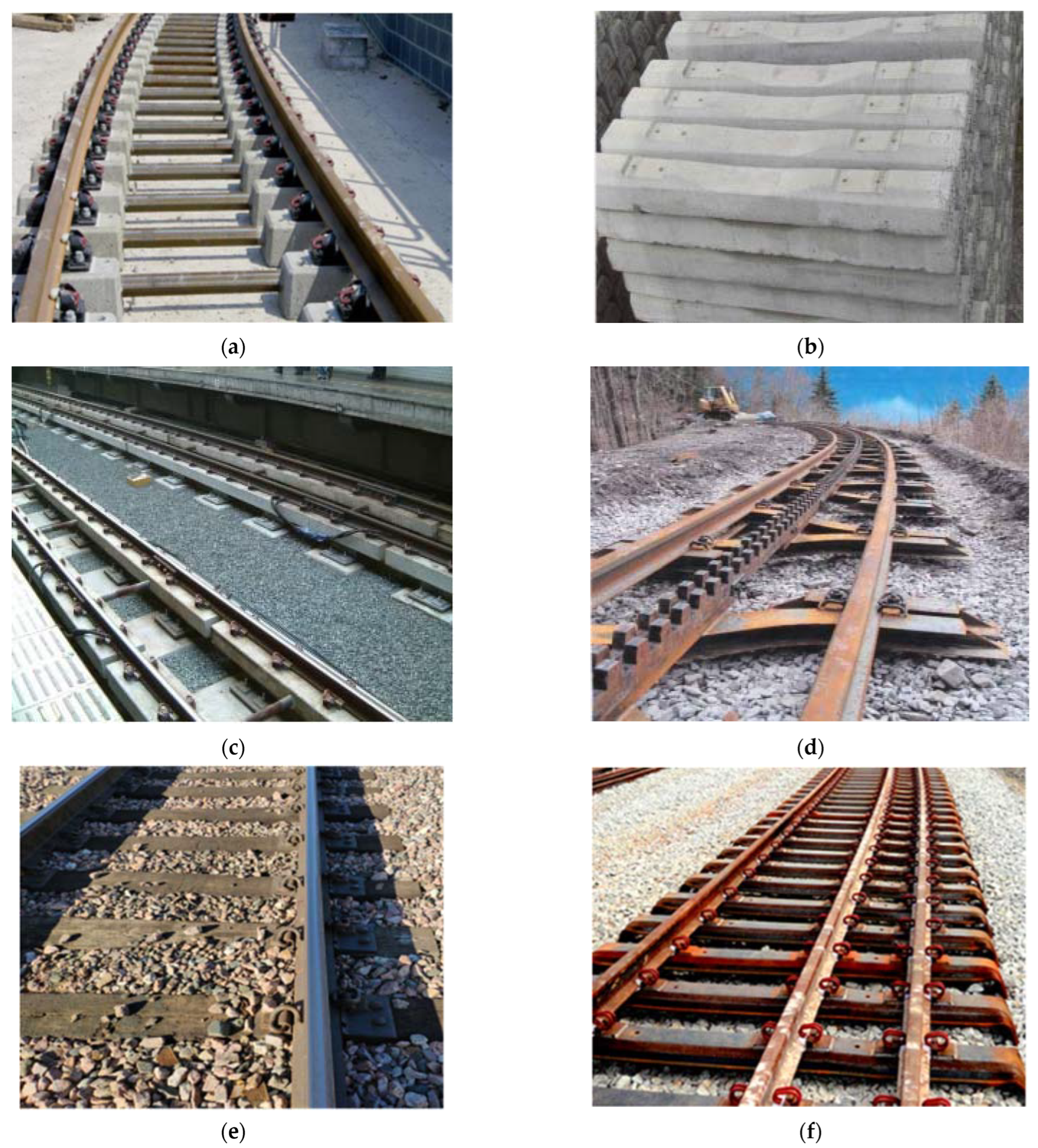
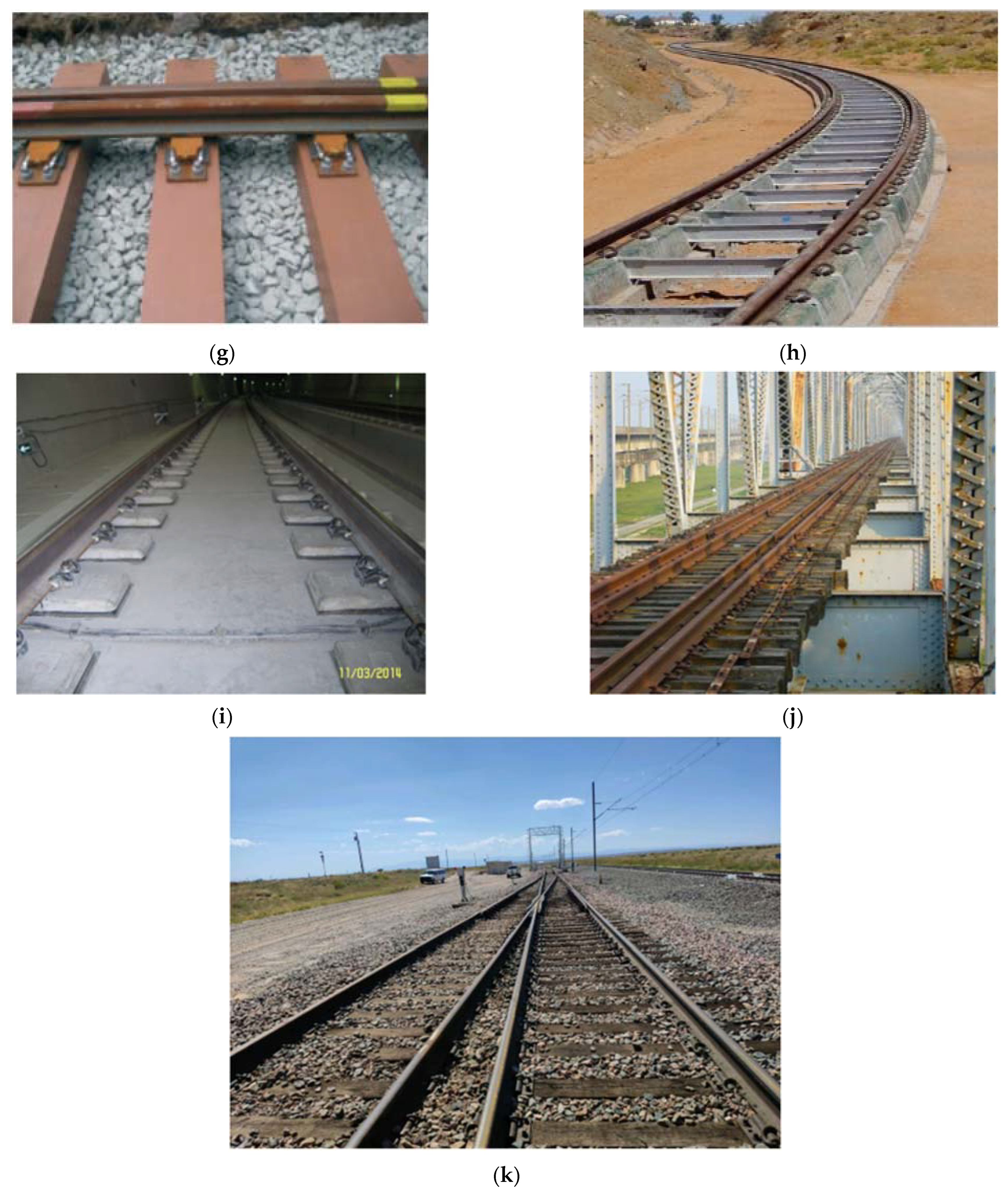



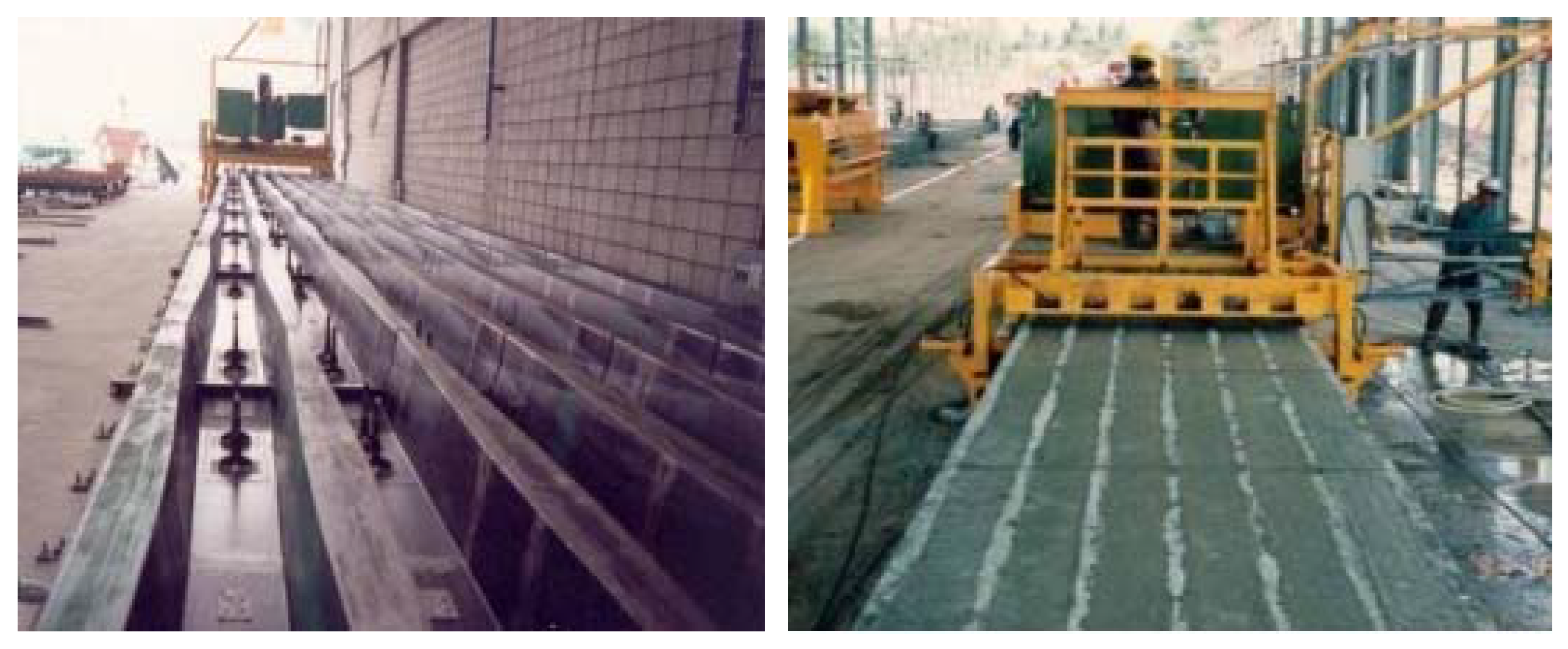
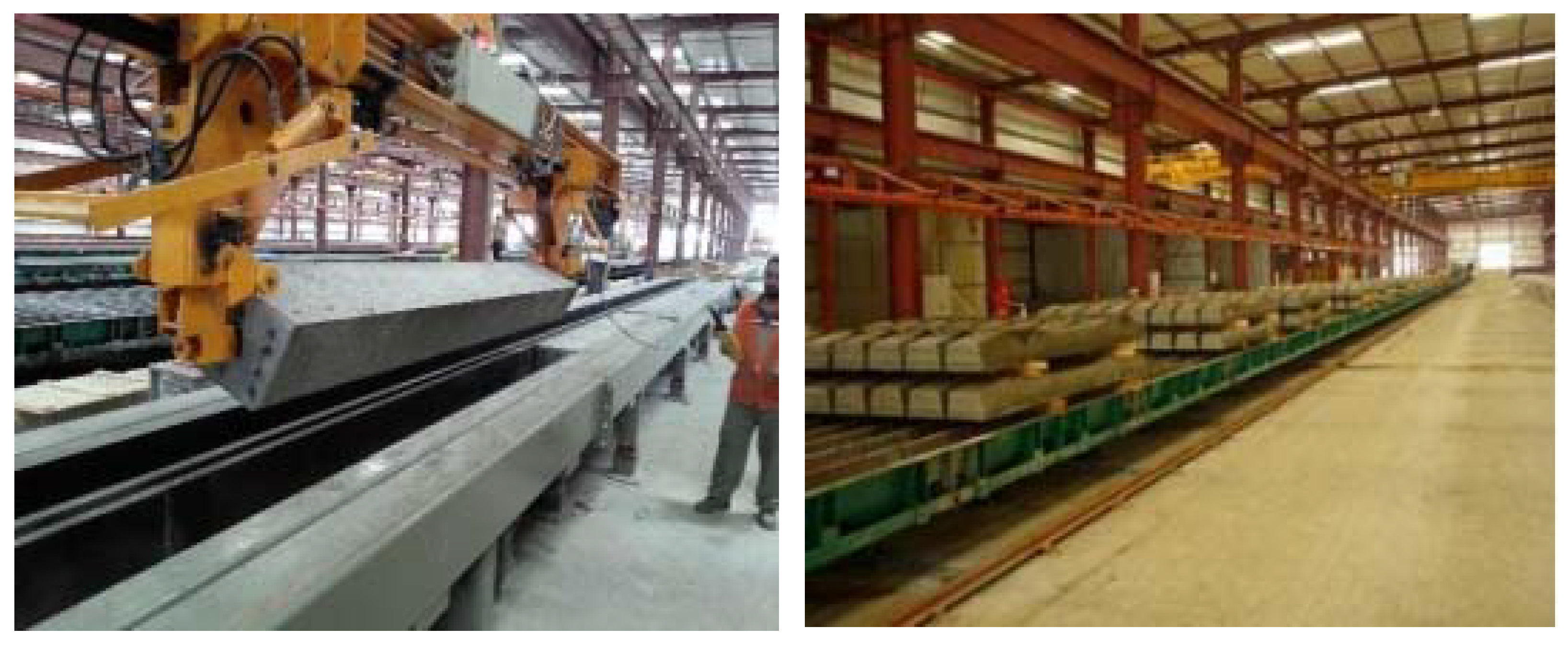



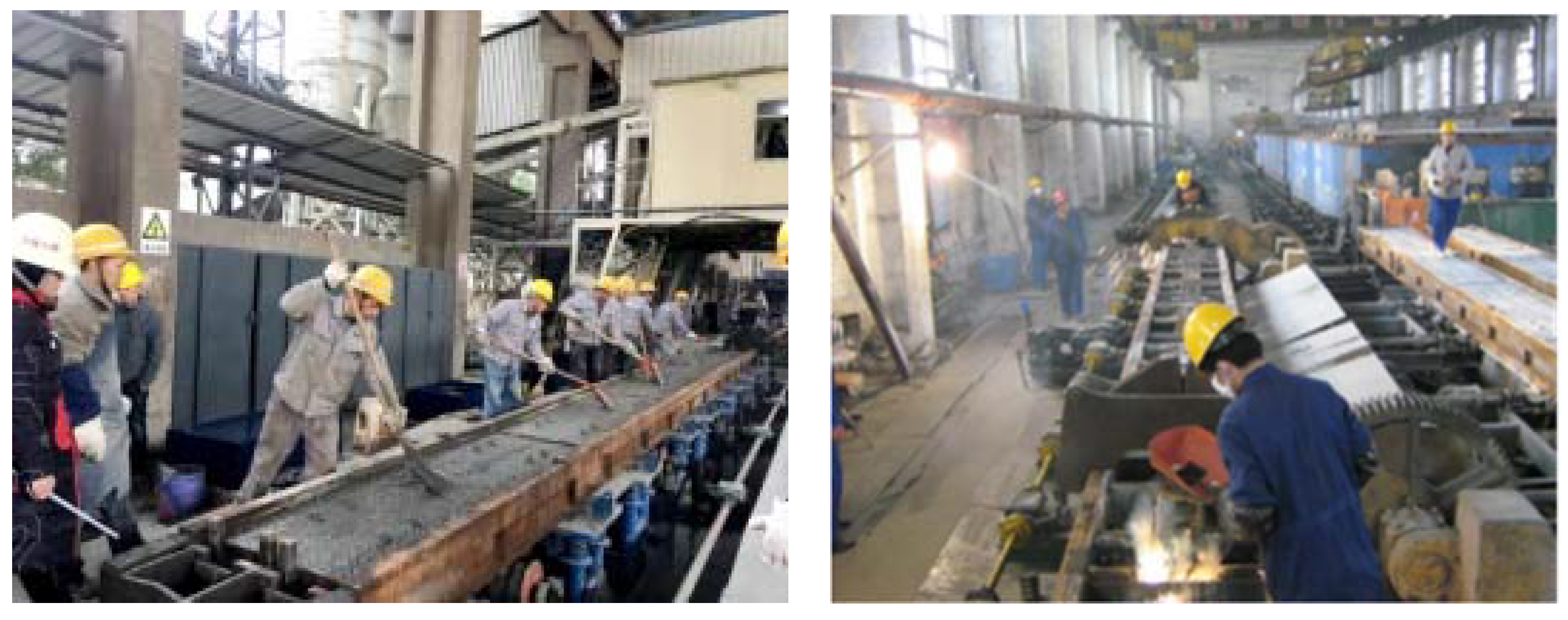

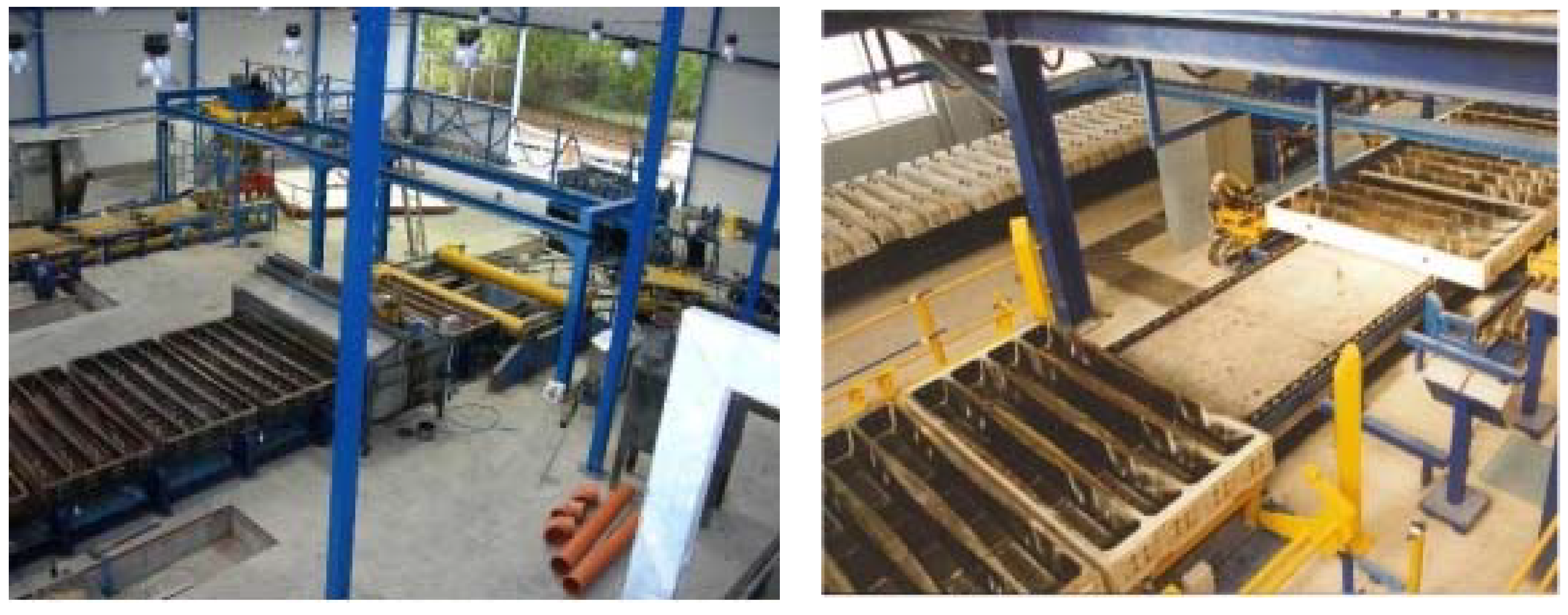
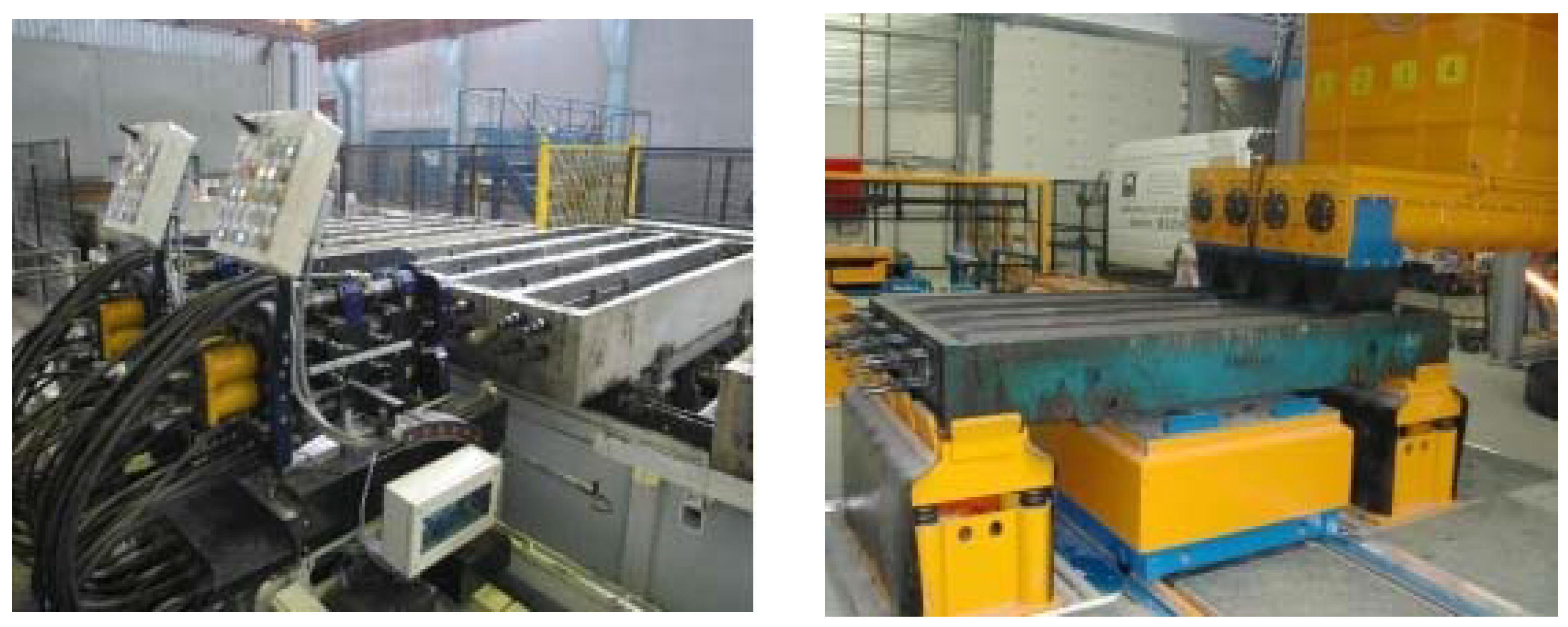
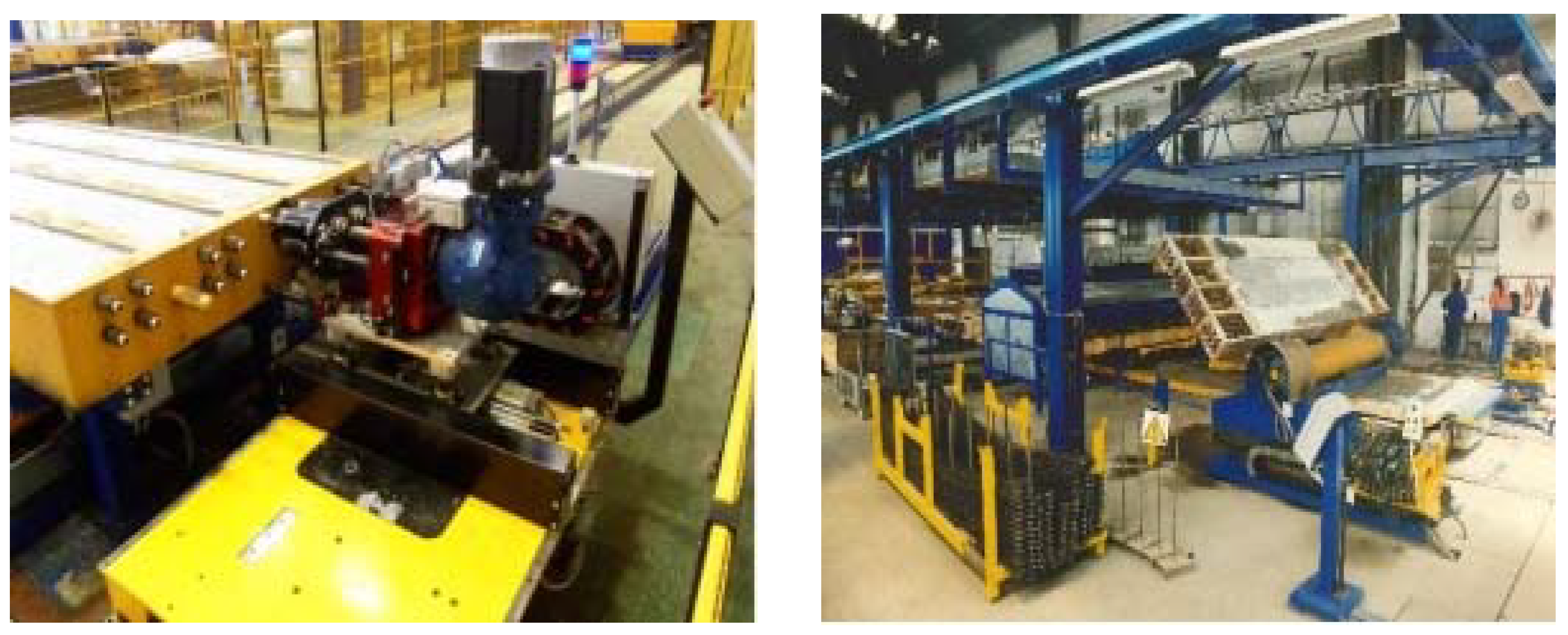

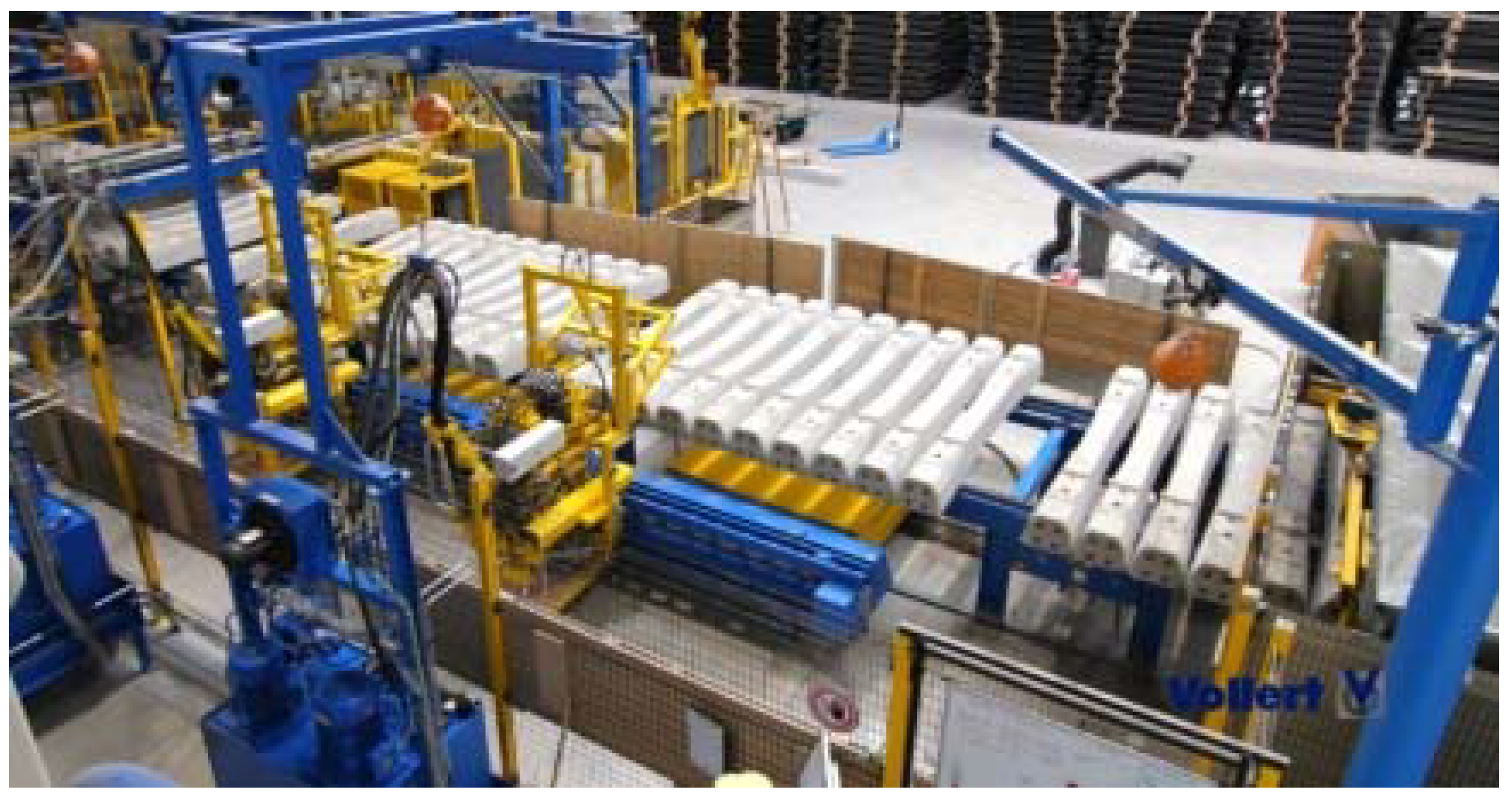
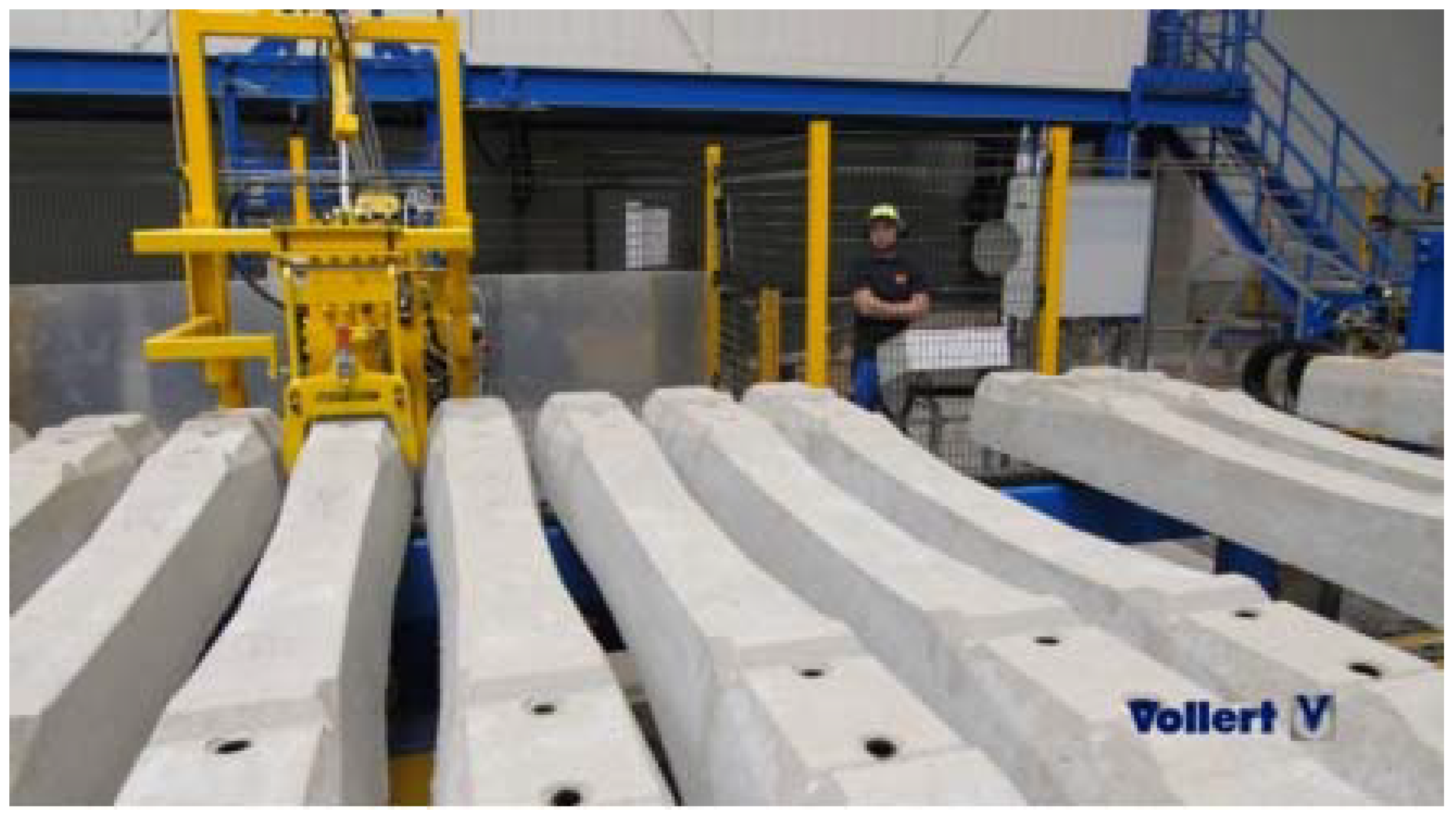
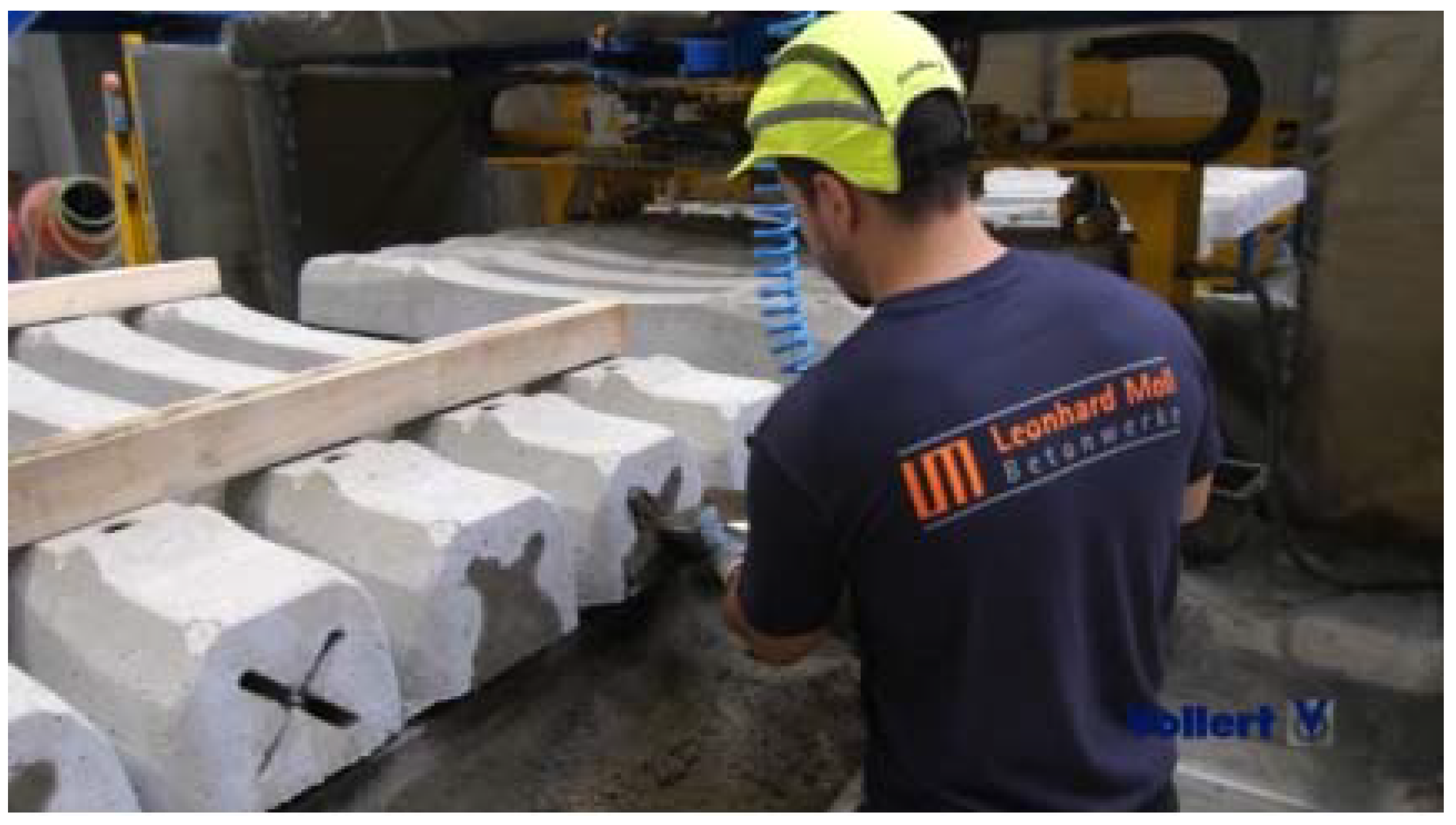
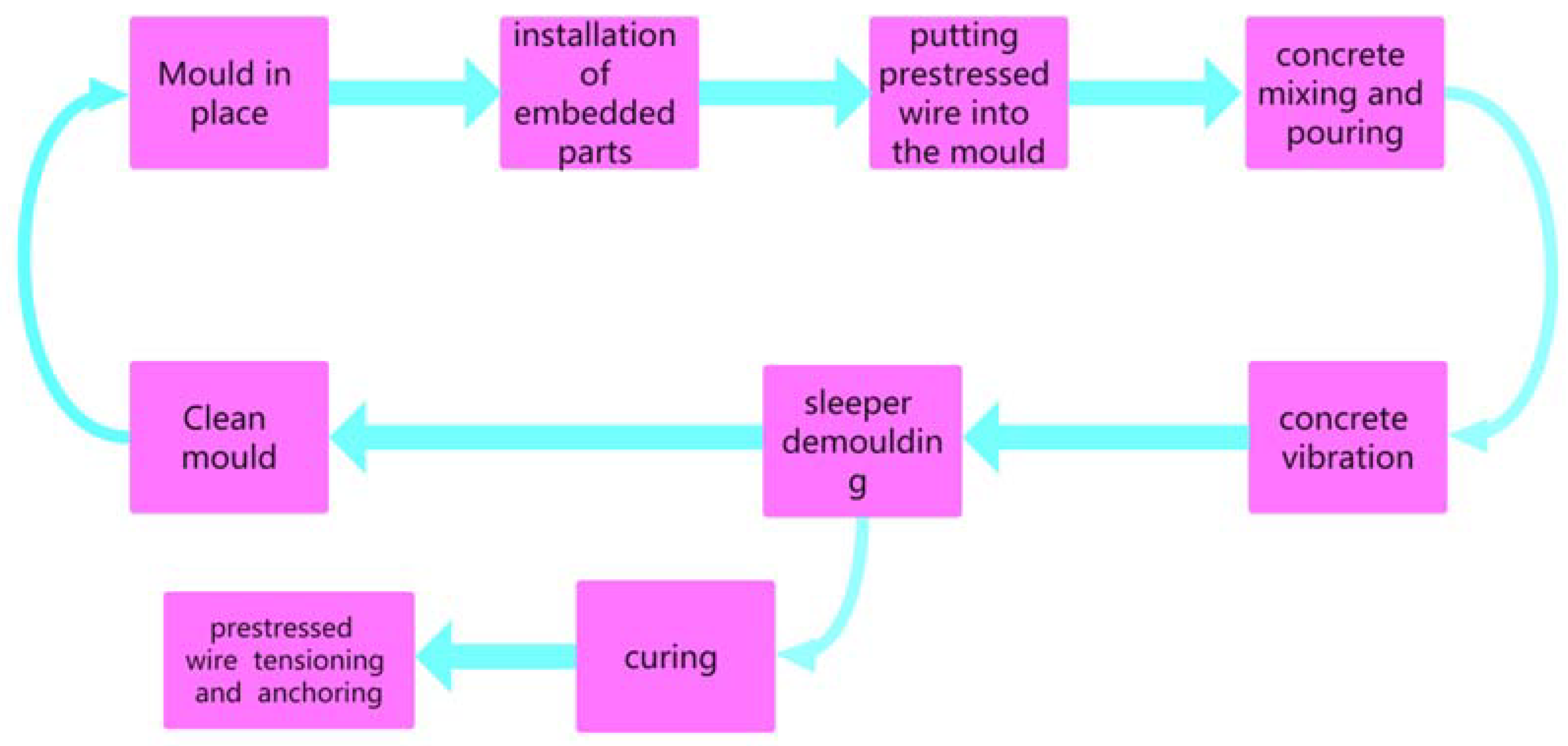

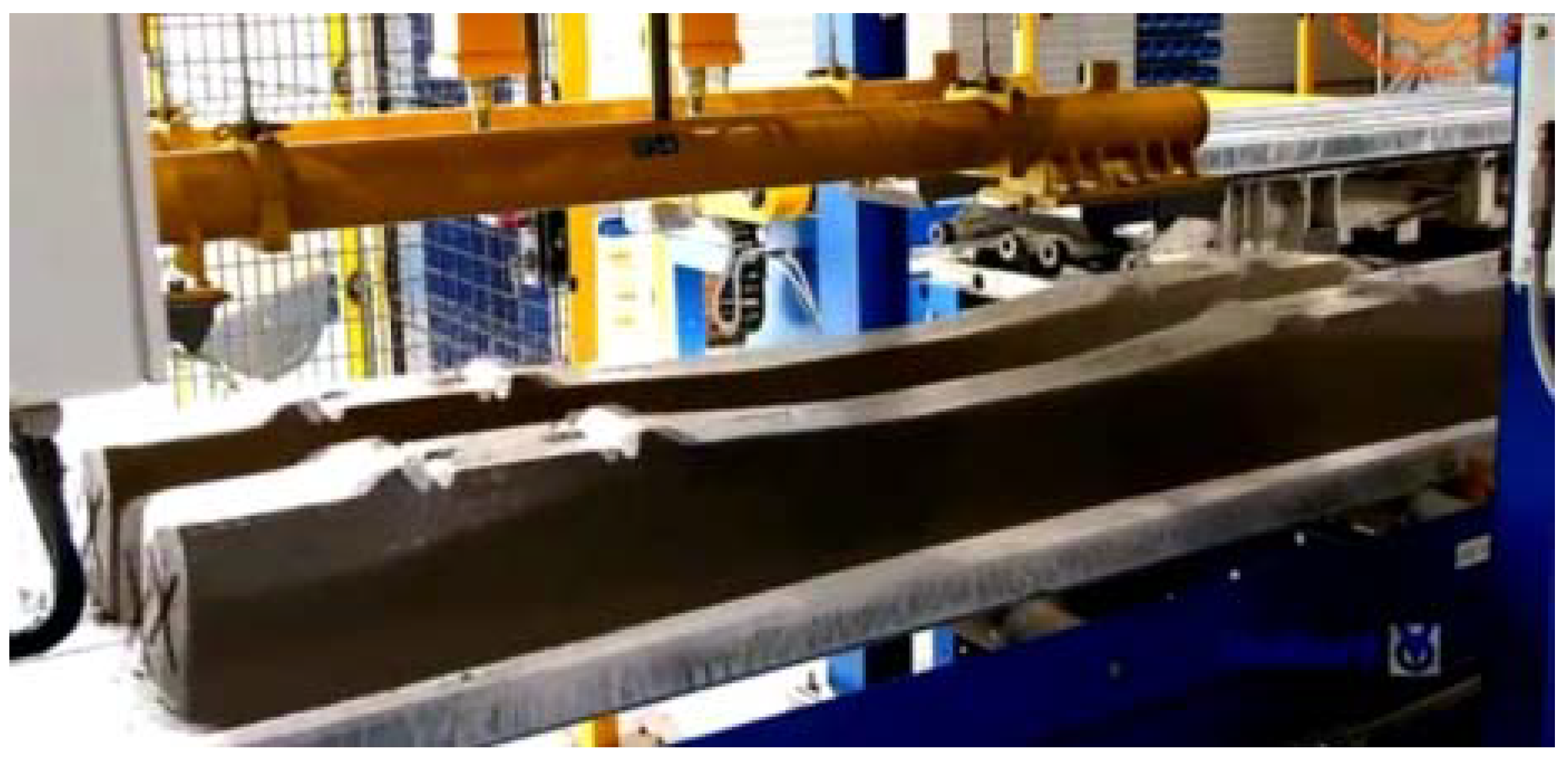
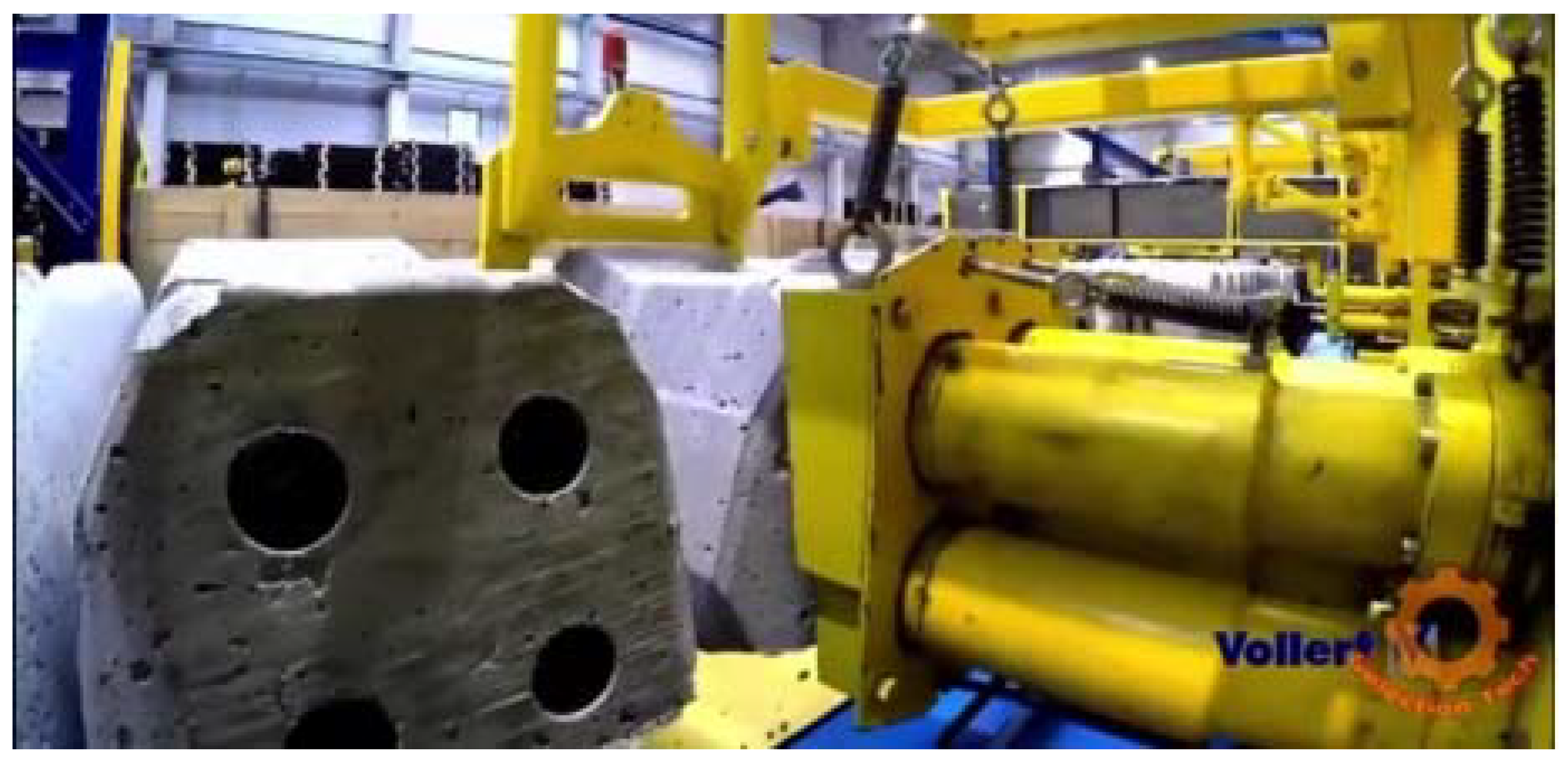

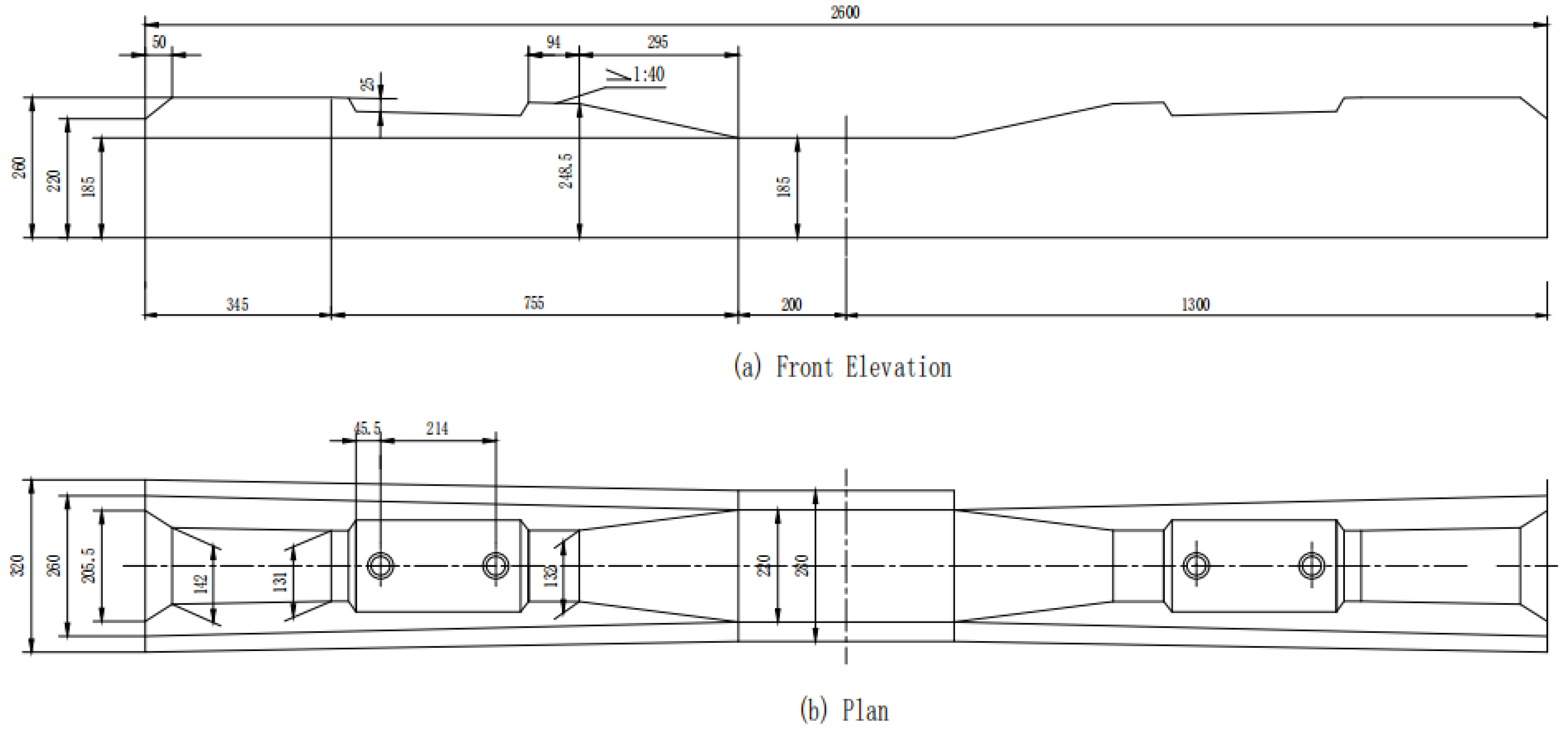
| 1 | Energy consumption | The mould is fixed in the production process, so it does not need large equipment, and the energy consumption of the production process is relatively low. |
| 2 | Labour | The production table position is fixed and the process flow is simple; therefore, less labour was needed—20 workers is enough for a production line. |
| 3 | Workshop environment | In the process of vibration compaction, the sleepers generally adopt the mode of plug-in vibration rod and attached vibration equipment, and the vibration noise is low. |
| 4 | Production line investment | Since the production equipment cost is not high and the production equipment mobility is good, the production line investment is low. |
| 5 | Production efficiency | Because the sleeper and the mould are maintained on the pedestal, the mould cannot be turned around and the production efficiency of the sleeper is low. According to the length of the mould and the number of seats, the daily production of the long-line pedestal method is 500 to 800 sleepers per shift. |
| 1 | Energy consumption | In the process of production, the mould flows in a different station and hence needs certain power equipment and hoisting equipment, and the production energy consumption is relatively high. |
| 2 | Labour | The process is simple and low automation in production requires a lot of labour—usually, a production line needs about 50 workers. |
| 3 | Workshop environment | In order to adapt to the mould flow and set up the process characteristics of the separator in the middle, dry hard concrete is generally used in the long die flow machine method, which leads to the need of large amplitude to dense vibration process, so the vibration noise in the production process is large. |
| 4 | Production line investment | The cost of production equipment is not high, so the input cost of the production line is relatively low; |
| 5 | Production efficiency | The sleeper mould on the production line has a high flow rate, so the production efficiency is high. The daily production of sleepers is 1000 to 1500 sleepers. |
| 6 | Production line versatility | The prestress is usually applied by the method of integral tension and transmitting, so the method could apply to different types of sleepers. |
| 1 | Energy consumption | In the process of production, the mould flows in different stations, so it needs certain power equipment and hoisting equipment, and the production energy consumption is relatively high. |
| 2 | Labour | Because the mould of single sleeper length is adopted, it is convenient to use automation equipment; therefore, the automation degree of this process production line is usually higher, and fewer workers are needed. |
| 3 | Production efficiency | The flow rate of short-mould on the production line is slightly higher than that of the long-mould method but, due to fewer sleepers in a single mould, the relative production efficiency is not high. The daily production of the short-mould flow method is around 800 to 1000 sleepers. |
| 4 | Product quality | The short mould length needs to have a large stiffness and good integrity, so the shape and dimension of sleepers can better be controlled. |
| 1 | Energy consumption | In the process of production, the mould flows in different stations; therefore, it needs certain power equipment and hoisting equipment, and the production energy consumption is relatively high. |
| 2 | Labour | Because the mould of single sleeper length is adopted, it is convenient to use automation equipment; therefore, the automation degree of this process production line is usually higher, fewer workers are needed. |
| 3 | Production efficiency | The flow rate of sleeper mould on the production line is slightly higher than that of the long-mould flow method, but due to the small number of sleepers in a single mould, the general production efficiency is not high. The daily production of short die flow machine group is 800 to 1000 sleepers |
| 4 | Product quality | The short mould length has a large stiffness and good integrity, so the shape and dimension of sleepers are better controlled. And the post-tensioning method is used to apply any prestress, the main reinforcement of sleepers usually uses prestressed steel with thread. |
| 1 | Energy consumption | In the process of production, the mould flows in different stations; therefore, it needs certain power equipment and hoisting equipment, and the production energy consumption is relatively high. |
| 2 | Labour | Because the mould of single sleeper length is adopted, it is convenient to use automation equipment; therefore, the automation degree of this process production line is usually higher, and fewer workers are needed. |
| 3 | Production efficiency | The flow rate of sleeper mould on the production line is slightly higher than that of the long-mould flow method, but due to the small number of sleepers in a single mould, the general production efficiency is not high. The daily production of short die flow machine group is 800 to 1000 sleepers |
| 4 | Product quality | Since the sleeper is required to maintain the shape after demoulding, the slump of concrete for sleeper production is important. Moreover, because the post-tensioning method is used to apply prestress, the main reinforcement of sleepers usually uses prestressed steel tendons with thread and anchor plates. Finally, because sleepers are not cured in the moulds, the sleeper curing temperature and humidity are easier to maintain. |
| Production Methods | Labour | Daily Capacity | Equipment Cost |
|---|---|---|---|
| Long Line System Method | About 20 persons | About 700 | Low |
| Pre-tensioned Long-mould Flow Method | About 50 persons | About 1200 | Low |
| Pre-tensioned Short-mould Flow Method | About 25 persons | About 800 | Medium |
| Post-tensioned Short-mould Flow Method | About 25 persons | About 800 | Medium |
| Instant-demoulded Short-mould Flow Method | About 20 persons | About 700 | High |
| Coefficient | I1 Value |
|---|---|
| Carbon emission coefficient of reinforcement | CO2 emission of 1-ton reinforcement is 3.1 kg |
| Cement carbon emission coefficient | CO2 emission of 1-ton cement is 3.1 kg |
| The carbon emission coefficient of the coarse aggregate | Power consumption of 1 ton of coarse aggregate is 1.17 kW, oil consumption is 0.723 L, convert into CO2 emission is 3.12 kg |
| Carbon emission coefficient of fine aggregate | consumption of 1 ton of fine aggregate is 1.5 kW, oil consumption is 0.78 L, convert into CO2 emission is 3.66 kg |
| Energy-carbon emission coefficient | Consumption of 1 kW energy, convert into CO2 emission is 1.00 kg |
| Fuel Type | Carbon Deficiency (kg·CJ−1) | Default of Carbon Oxide Factor | Effective CO2 Emission Factor (kg·TJ−1) | ||
|---|---|---|---|---|---|
| A | B | Default Value C = AB × 44/1.2 × 104 | 95% Confidence Interval | ||
| Low | High | ||||
| Automobile gasoline | 18.9 | 1 | 69,300 | 67,500 | 73,000 |
| Aiesel oil | 20.2 | 1 | 74,100 | 72,600 | 74,800 |
| Production Methods | Carbon Emission of Steel Bar C1 | Carbon Emission of the Cement C2 | Carbon Emission of Coarse Aggregate C3 | Carbon Emission of Fine Aggregate C4 | Carbon Emission of the Concrete Mixing C5 | Carbon Emission of Sleeper Production C6 | Total Carbon Emission CT |
|---|---|---|---|---|---|---|---|
| Long-line system method | 0.19 | 52.24 | 4.18 | 2.27 | 0.58 | 1.03 | 60.50 |
| Pre-tensioned long-mould flow method | 0.19 | 52.24 | 4.18 | 2.27 | 0.34 | 1.39 | 60.62 |
| Pre-tensioned short-mould flow method | 0.19 | 52.24 | 4.18 | 2.27 | 0.51 | 2.50 | 61.90 |
| Post-tensioned short-mould flow method | 0.19 | 52.24 | 4.18 | 2.27 | 0.51 | 2.20 | 61.60 |
| Instant-demoulded short-mould flow Method | 0.19 | 52.24 | 4.18 | 2.27 | 0.58 | 2.86 | 62.33 |
| Production Methods | Carbon Emission of Steel Bar C1 | Carbon Emission of the Cement C2 | Carbon Emission of Coarse Aggregate C3 | Carbon Emission of Fine Aggregate C4 | Carbon Emission of the Concrete Mixing C5 | Carbon Emission of Sleeper Production C6 |
|---|---|---|---|---|---|---|
| Long-line system method | 0.32% | 86.35% | 6.91% | 3.75% | 0.96% | 1.70% |
| Pre-tensioned long-mould flow method | 0.32% | 86.18% | 6.90% | 3.75% | 0.56% | 2.30% |
| Pre-tensioned short-mould flow method | 0.31% | 84.40% | 6.76% | 3.67% | 0.82% | 4.04% |
| Post-tensioned short-mould flow method | 0.31% | 84.81% | 6.79% | 3.69% | 0.83% | 3.57% |
| Instant-demoulded short-mould flow Method | 0.31% | 83.82% | 6.71% | 3.64% | 0.94% | 4.58% |
Publisher’s Note: MDPI stays neutral with regard to jurisdictional claims in published maps and institutional affiliations. |
© 2022 by the authors. Licensee MDPI, Basel, Switzerland. This article is an open access article distributed under the terms and conditions of the Creative Commons Attribution (CC BY) license (https://creativecommons.org/licenses/by/4.0/).
Share and Cite
You, R.; Wang, J.; Kaewunruen, S.; Wang, M.; Ning, N. Comparative Investigations into Environment-Friendly Production Methods for Railway Prestressed Concrete Sleepers and Bearers. Sustainability 2022, 14, 1059. https://doi.org/10.3390/su14031059
You R, Wang J, Kaewunruen S, Wang M, Ning N. Comparative Investigations into Environment-Friendly Production Methods for Railway Prestressed Concrete Sleepers and Bearers. Sustainability. 2022; 14(3):1059. https://doi.org/10.3390/su14031059
Chicago/Turabian StyleYou, Ruilin, Jijun Wang, Sakdirat Kaewunruen, Meng Wang, and Na Ning. 2022. "Comparative Investigations into Environment-Friendly Production Methods for Railway Prestressed Concrete Sleepers and Bearers" Sustainability 14, no. 3: 1059. https://doi.org/10.3390/su14031059
APA StyleYou, R., Wang, J., Kaewunruen, S., Wang, M., & Ning, N. (2022). Comparative Investigations into Environment-Friendly Production Methods for Railway Prestressed Concrete Sleepers and Bearers. Sustainability, 14(3), 1059. https://doi.org/10.3390/su14031059








